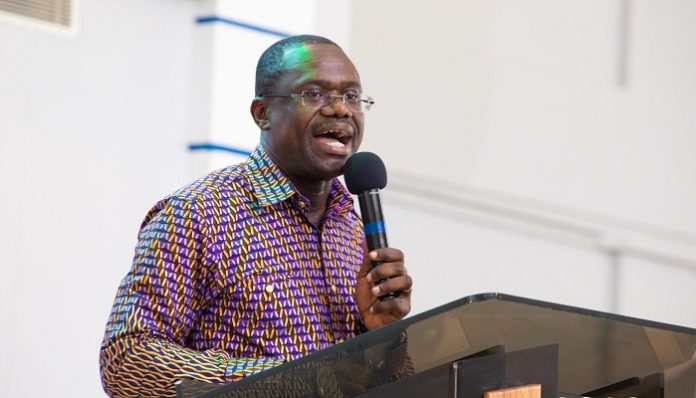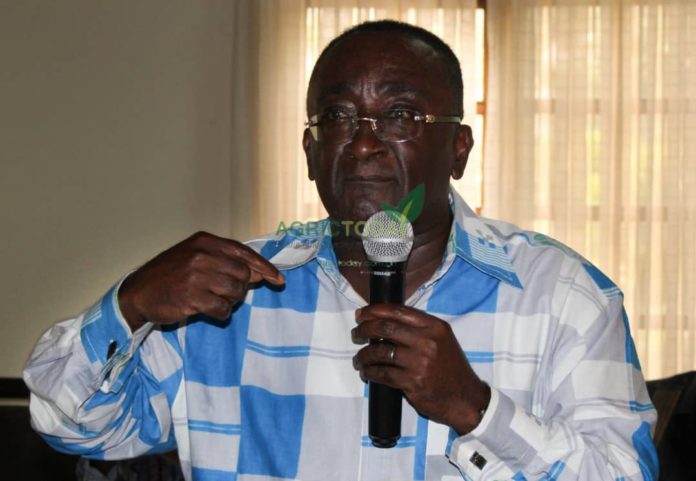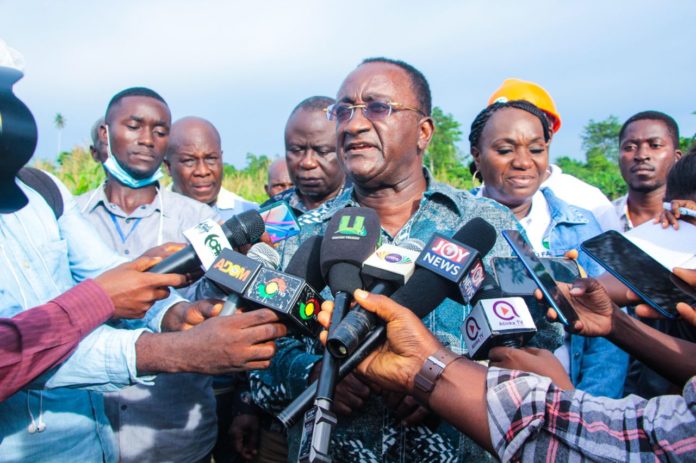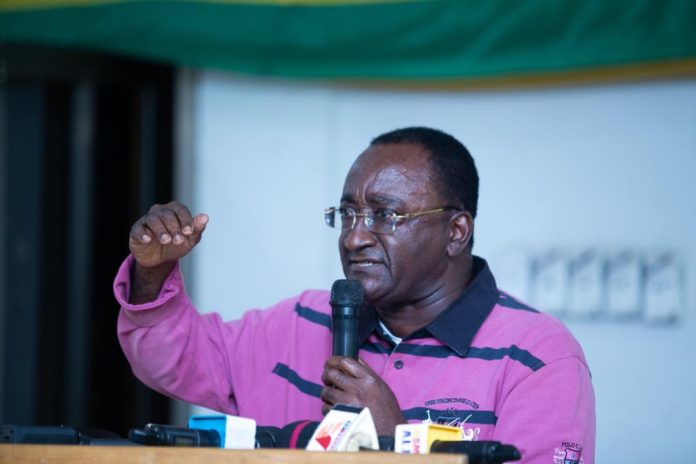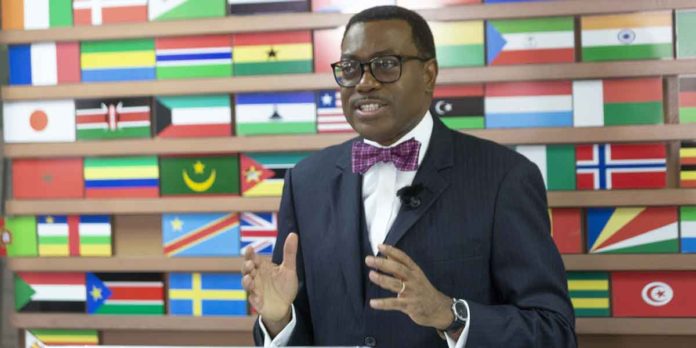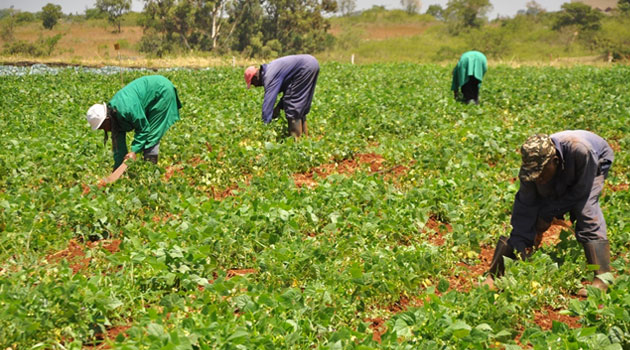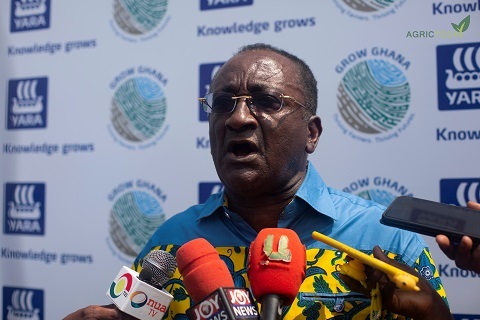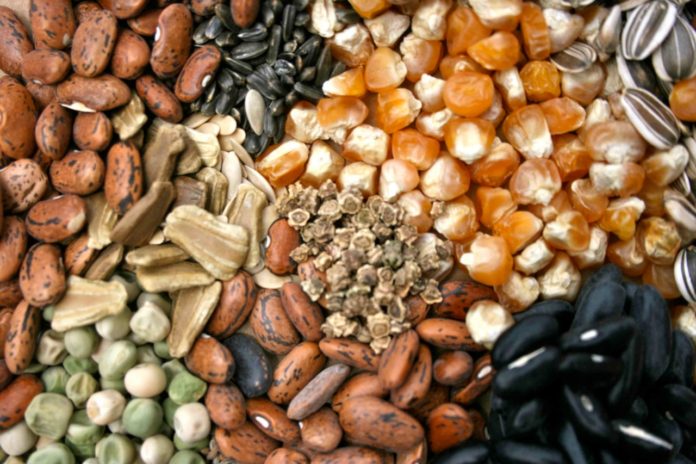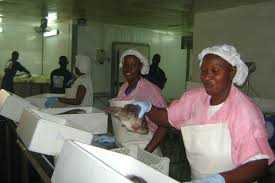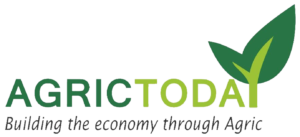As part of the efforts to help address challenges hampering the production of cocoa in the country; SEND Ghana in partnership with INKOTA Netzwerk and SUDWIND has taken another judicious step by meeting key stakeholders within the cocoa value chain to discuss issues bothering living income and human rights in Ghana’s cocoa sector.
Jospong Group to support and develop the rice sector to cease rice importation.
Rice is the second most consumed food commodity in Ghana cuisine. Ghana imports rice worth millions of dollars every year derailing economic growth. Ghana’s rice production is about 960,000mt as against 1.4mmt consumption making it dependent on foreign countries for the rest of the quantity consumed.
Transportation cost is not responsible for price hikes of food commodities – Agric Minister
The Minister for Food and Agriculture, Dr. Owusu Afriyie Akoto, says the high cost of transportation is not to blame for soaring food prices.
The latest figures show inflation for October is more than 40% driven largely by food and transportation prices.
Food inflation recorded the highest rate among all the components as against non-food inflation according to the Ghana Statistical Service.
Many have suggested that the astronomical rise in the prices of petroleum products is taking a toll on transportation rates, which is then borne by the consumer.
But answering questions in Parliament, the Minister said the analysis of the Ministry does not point to transportation costs as the cause of the hikes.
He however fell short of explaining exactly what is causing the increase.
The Minister also defended his outfit’s plans to bring food from the local areas to Accra in order to compete with the high cost of food on the market.
The increase in food inflation indicates a jump of more than 3 percent from the previous rate of 37.2%.
Addressing the media, Government Statistician, Prof Samuel Kobina Annim explained that all items in the component for calculating the rate of inflation recorded an increase.
“For the month of October, Food inflation was 43.7%. Last month’s Food inflation was 37.8%. A careful study of the figures show that month-on-month Food inflation was 3.2%.” he said.
Government to support farmers with $150m Indian Exim Bank facility.
The Minister of Food and Agriculture, Dr. Owusu Afriyie Akoto says the Ministry of Food and Agriculture (MoFA) is arranging a US$150 million from Indian Exim Bank facility to support farmers in the Southern, Middle and Northern belts of the country.
According to him, a detailed project report for implementation has been prepared by a consultant.
The sector minister revealed this on the floor of Parliament in Accra in response to a question from Member of Parliament for Awutu-Senya West, Mrs Gizella Tetteh-Agbotui on efforts the Ministry is instituting to establish mechanisation centres for farmers in the Awutu-Senya District.
Dr. Afriyie Akoto cited that since 2018, the MoFA has imported various agricultural machinery and equipment from Brazil for sale to interested farmers, institutions and new investors at subsided rates across the country.
“Mr. Speaker, this is intended to promote the establishment of private sector-owned mechanisation centres to support farmers,” the Minister said.
Dr. Afriyie Akoto stated that mechanisation centres are to bring smallholder farmers together as a group to have the services of mechanisation at subsidised rates.
Ghana’s food security status strengthened- Agric Minister.
The Minister of Food and Agriculture, Dr. Owusu Afriyie Akoto has noted that, interventions by the current government in the last five years have laid a solid foundation for sustainable food availability, accessibility, utilization and stability even in times of major adversity, food production has been consistent, ensuring the needed stability and resilience that every country needs to survive.
He said, this has been made possible through the sound and pragmatic policy of the government and everyone should support the ongoing effort to build a strong food sector that ensures self-reliance, value addition and the needed linkage to industries.
According to Dr. Owusu Afriyie Akoto “Government’s investment toward National Food Security within the space of 5 years from 2017, I dare say is unparalleled in the history of this country”.
Responding to an urgent question from, MP for Gomoa east, De-Graft Piatoo on measures the Ministry intends to adopt or have adopted to improve on food security in the country, the Minister said, FAO has established four 4 pillars of food security namely: Availability, Accessibility, Utilization and Stability and “using these pillars as a basis for assessing the status of Ghana’s food security, there is no question that Ghana is more than food secure”.
On food availability, the Minister said, “since the rollout of the government flagship programme Planting for Food and Jobs (PFJ) in April 2017, data and physical evidence amply attest to a consistent and enhanced food security status of the country. At the very outset, the PFJ campaign signaled the very high premium placed on food security by the government. This explains why the food crop module of the PFJ was the first to be out-doored”.
In terms of food utilization, he said, “Ghana annually experiences a lot of waste and surpluses, to address these problems the government is constructing 80 warehouses across the country.
Most of these warehouses are currently being put to use at District Assemblies after completion to ensure that these warehouses are put to optimal use to serve their purpose.
The Ministry is inviting private sector participation in the management of that facility and advert to that effect has been put in the newspaper, expression of that effect from the private sector”.
Africa needs more climate funds to adapt to climate change – Adesina.
President of the African Development Bank, Akinwumi Adesina, has emphasised that Africa needs more climate support funds to address issues of climate change on the continent as nine out of the 10 most vulnerable countries to climate change are in Africa.
According to him, with the annual climate financing gap at around US$110billion, adaptation to climate change cannot be implemented in its totality unless there is a paradigm shift to funding.
He stated further that for Africa to meet its climate actions obligations under the Paris Agreement, and be able to do climate financing, it needs to get between US$1.3trillion to US$1.6trillion by 2030, bringing an average of US$127billion a year in climate finance; and yet Africa gets only US$18billion, leaving a balance of US$110billion, hence, the importance for developed countries to pay up the financing gap.
“So, putting all these together, Africa is choking from climate change; but again, Africa is underfunded with the finance it needs to tackle its climate change, getting only three percent of the total global climate change finance.
“This is highly disproportionate to the needs Africa has. Today, Africa is losing seven to US$15billion of its productivity a year because of climate change. If actions are not taken rapidly, that will draw to US$50billion a year by 2030,” he said.
He mentioned that a lot of the impact of climate change in Africa is seen in areas of increased levels of drought, flood and heat, affecting crops and livestock production, which will again affect the livelihoods of farmers while threatening food security.
Africa Climate Action Window
Furthermore, he stated that AfDB has created a downstream facility – the Africa Development Fund (ADF) – to mobilise US$13billion for the Africa Climate Action Window, aimed at supporting 37 countries in Africa to tackle climate action.
“This Climate Action Window is very critical for low-income countries in Africa and transition states. This climate window will provide 20 million farmers with access to climate-resilient agriculture technologies. It will also support 20 million farmers and pastoralists to gain access to weather index insurance scores for insuring their livelihoods.
“This will again provide 18 million people with access to water and sanitation, and also provide 840 billion cubic metres of water because water will be critical for the population,” he said.
The president concluded that this facility will also provide about 10 million people with access to clean energy.
Considering all these important interventions and initiatives to tackle climate change, Mr. Adesina reiterated that Africa needs more to tackle climate change; hence, the need to move from words to commitments, commitments to actions, and actions to delivery of money on the table for Africa to deliver on climate change.
He made these remarks during a virtual pre-COP27 press conference and global launch of the ‘State and Trends in Africa 2022 (STA22)’.
On his part, CEO of the Global Centre Adaptation (GCA), Prof. Patrick Verkooijen, stated that Africa is on the frontline of a climate emergency it did not create. He added that Africa’s 1.4 billion people, which is about 17 percent of the global population, contribute almost nothing to global warming, and are responsible for less than three percent of the world’s total greenhouse-gas emissions, yet is very vulnerable to its impacts; hence, the need to pay more attention to investments which mitigate the impact.
“The bottom line is this: if COP27 is to succeed, it needs to ensure that adaptation finance is finally flowing at full scale and pace to Africa. It is clear now that we can no longer afford to wait; adaptation must start happening on a far greater scale with a paradigm shift in investment,” he said.
State and Trends in Adaptation, Africa Report 2022
The State and Trends in Adaptation in Africa. Report 2022 (STA22) completes the most comprehensive overview of present and projected climate risks and adaptation solutions in Africa. STA22, the third in GCA’s series of annual flagship reports, maintains the dedicated focus on Africa from last year and expands its analysis.
The report provides a deep dive into the economics and finance of climate change adaptation, with an additional focus on sectors, cross-sectoral themes and country profiles. It sets out the potential costs and benefits of adaptation interventions in Africa, and includes a new analysis of climate change impact on the private sector.
All farmers need to adopt best practices to meet climate targets – Hackett.
All farmers and farm types need to adopt best practices if the agriculture sector is to prosper in a sustainable way and meet environmental targets set out for 2030 and 2050, Minister of State, Pippa Hackett has said.
While there is no doubt that this is a very challenging time for agriculture, Minister Hackett said it is also “hugely exciting” because of pioneering work being done in organic farming, regenerative farming, and agroforestry.
Focusing on soil health, crop rotation, grazing and pasture management, and using plants and crops to help enrich and improve soil biology are practices that should apply on all farms, she said.
The minister with responsibility for land use and biodiversity at the Department of Agriculture, Food and the Marine (DAFM), opened Biofarm 2022, Ireland’s Biological Farming Conference today (Monday, November 7).
“We have huge ambitions here in Ireland, and indeed across the globe, to turn the tide on increasingly negative trends from our food production systems – be that in greenhouse gas emissions, biodiversity loss, water and soil quality.
“And if we are to deliver on our targets, or even come close to delivering on them, an enormous amount of the heavy lifting will fall to the agricultural sector,” according to Minister Hackett.
The fifth annual biological farming conference organised by the National Organic Training Skillnet (NOTS) will take place in person and online until Friday, November 11 at the Landmark Hotel, Carrick-on-Shannon, Co. Leitrim.
Key issues facing the farming sector that will be explored at the conference include climate change, carbon sequestration, rising input costs, and farm profitability.
Best practices.
Soil health, and grazing and pasture management are among the areas that need to be improved and focused on in the years and decades ahead, the minister said, adding that “it is not always easy, and a shift in mindset is often needed”.
The Russian invasion of Ukraine has meant that change has been thrust upon many farmers, with reduced fertiliser use coming about in many cases by economic necessity, rather than by environmental concern, or government incentives, she said.
Many farmers in Ireland have seen continued grass growth this year, despite the reduction in chemical fertiliser, and it may be possible to move towards a model that relies less on synthetic inputs, according to the minister.
The government has a role to play through incentives, such as supporting multi-species swards, red clover use, the Agri-Climate Rural Environment Scheme (ACRES) and the Organic Farming Scheme (OFS), as well as through the nitrates regulations and the upcoming fertiliser regulations, the minister said.
Minister Hackett added that already hundreds of farmers have been taken into the new OFS which opened over two weeks ago. She commented:
“I know from my own experience when we made the switch to organic farming nearly 10 years ago, that things can be challenging. In a way we had to relearn farming without the crutch of chemical inputs.
“We had to plan further ahead, and we had to have a little faith and believe in our own skills and knowledge, and in the soil beneath our feet,” the minister said.
While it is clear that many farms want to play their part in the move towards truly sustainable farming, she said, to do so requires an openness and willingness to do things differently.
“This is the system change that is needed, because tinkering around the edges of business as usual will no longer cut it,” according to Minister Hackett.
Current food prices in Accra are over exaggerated- Agric Minister.
Minister for Food and Agriculture, Dr. Owusu Afriyie Akoto has intimated that even though the high cost of fuel has contributed to food price hikes recently, prices in urban centres, particularly Accra, are over exaggerated.
The situation, he said, is creating the impression that food has become inaccessible in the country, which is not true.
The Minister, in responding to questions on the Floor of parliament said: “Food accessibility in Ghana is also more than satisfactory. In recent times, price hikes of food commodities in the urban centres particular Accra, is creating an erroneous impression that food has become inaccessible.
I have just returned from a tour of regions in the southern belt of the country and I can assure you that prices in the urbans centres particularly Accra, are a far cry from what obtains in particular production centres in the regions.
Many attribute the high increases to the cost of fuel and transportation. Whereas this may be true to some extend, our analysis at the ministry review that it is over exaggerated.”
He further added that his ministry, in a bid to manage the situation, is arranging to transport food from production centres directly to Accra.
The move, he noted, will provide food at reasonable prices to the public and workers in the area.
Meanwhile, latest figures from the Ghana Statistical Service show inflation for October is more than 40 percent, a case which is largely driven by food and transportation prices.
The revised Seed Sector Strategy and Investment Plan will boost agricultural production – Stakeholders.
Agricultural sector stakeholders in Ghana have expressed confidence that a revised Seed Sector Strategy and Investment Plan currently being drafted will boost the country’s agricultural production.
A four-day meeting opened in Ghana’s capital Accra on Monday with about 60 seed experts from across the country and the sub-region participating, to draft the new strategy.
The new strategy will review the National Seed Plan of 2015.
The National Seed Plan describes the specific actions to be taken to implement the National Seed Policy which was launched in May 2013.
The policy recommends actions the country should take to improve the seed system including research and variety development, seed production, seed marketing, seed entrepreneurship, and the regulatory environment, among other areas.
The meeting dubbed the 3rd National Seed Forum is under the theme, “Facilitating the Seed Industry through Knowledge, Collaboration and Strategic Planning.”
The Seed Sector Strategy and Investment Plan is expected to strengthen Ghana’s seed industry by promoting the adoption and utilisation of certified seed by the country’s farmers.
“The Ghana National Seed Council believes that the forum, with various activities over the next four days, will launch a wonderful period of polishing up to accelerate the industry and address the remaining issues, which will complementarily address the needs of our hardworking farmers, agro-industry, and the consuming public,” said Josiah Wobil, Chairman of Ghana’s National Seed Council.
Regina Richardson, Programs Officer at AGRA told the meeting, “The 3rd National Seed Forum is being held at an opportune moment when the seed sector needs to consolidate the gains made and develop sustainable models to address constraints inhibiting the growth of the sector.”
Officials from the Ministry of Food and Agriculture (MoFA), the National Seed Trade Association of Ghana (NASTAG), The African Seed Access Index (TASAI), and other seed sector stakeholders are participating in the meeting.
Kwabena Adu Gyamfi, President of NASTAG observed that “Food has become very relevant in Ghana today looking at the economic issues. Food is driving inflation and we have no business sitting down and not looking at our seed sector.”
Ghana’s seed sector has grown tremendously in the past few years, with the development and availability of improved and locally adapted seed varieties.
However, the adoption is still marginal, with just about 30% of the farmers using the improved varieties.
The slow pace of adoption is linked to inadequate compliance with seed legislation by various key seed value chain operators, and the disregard of the rules and procedures of the Seed Certification and Standard Regulations.
Kwasi Wih who is head of the Ghana Seed Inspection Division of Plant Protection and Regulatory Services Directorate (PPRSD) of the Ministry of Food and Agriculture, said stakeholders will ensure that they take advantage of the forum to help improve the seed industry.
“Quality seeds are the pre-requisite to successful agriculture and constitute a major pathway for the achievement of national security goals…There is a need to ensure the widespread availability of quality seeds throughout the country.
“It’s important that institutions and structures required to support the implementation of a good seed system are streamlined and properly equipped and managed to ensure the seed sector plays its required role in the country’s agricultural transformation,” he said.
The four-day workshop follows a successful deployment of the Seed Systems Analysis Tool (SeedSAT), to analyse the functioning of eight key thematic areas of the national seed system and make prioritized recommendations for interventions to support a robust seed sector.
A communique will be issued at the end of the workshop on the way forward in developing the new strategy. AGRA is leading this effort with the support of the U.S. Government through the U.S. Agency for International Development (USAID), and the Bill & Melinda Gates Foundation (BMGF), under the Partnership for Inclusive Agricultural Transformation in Africa (PIATA) umbrella.
Lily Amber Kenny who is Director of the Economic Growth Office at USAID said Ghana’s farmers can be a breadbasket for all of West Africa with the proper financing resources and tools which include seeds and fertilizers.
“Insufficient quantities of certified seeds, foundation seeds, and breeder seeds that drive the supply chain are key constraints affecting the growth and competitiveness of the seed sector,” she observed.
“As we enter a new phase of programming with AGRA, this event (3rd National Seed Forum) is very timely, given the circumstances and the challenges farmers have getting improved seeds and inputs”, she said.
Be prepared to buy soup, stew in addition to your fufu, rice – some restaurant owners hint
Some restaurant owners in the Ashanti Region are entreating customers to make provision to buy soup and stew for their fufu and rice due to the rising cost of food stuff.
The business owners say ingredients such as oil, meat and vegetables, are taking a toll on their operations.
They want the government to intervene before the end of November to avert the unpleasant experience for customers.
Sam Charles, who speaks for the group, told Nhyira FM’s Obidehyie Ofori Amanfo that dishing out soup and stew for free at restaurants is killing their businesses
“We are giving the government up to the end of this month, if things continue like this, then be ready to put money aside to buy soup and stew. We can’t give these for free and run at a loss. It is not easy. What wrong have we done for giving our power to one person to lead us,” he questioned.
“When someone talks about it, they say the person has been bribed, you will come and buy soup to taste the reality too.”, he added.
Sam Charles said some staff of restaurants are losing their jobs as businesses struggle to sustain operations.
“We have now started laying off our workers, because we can’t pay them. We are running at a loss. Now when you come to the restaurant, you pick your bowl and wash, so you buy your food with it.”
The food industry falls under the Tourism Ministry, but the entrepreneurs said there has been no support system.
Sam expressed worry about the future of the food industry.
“The food industry falls under the tourism industry, but they have neglected us and are concentrating only on creative art. When the government initiated the year of return, most of the visitors were mostly talking about our local foods. But the tourism industry doesn’t care about us, even for training they don’t give to us often. We have been struggling on our own,” he lamented.


